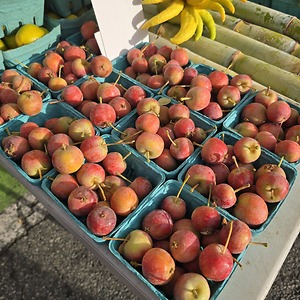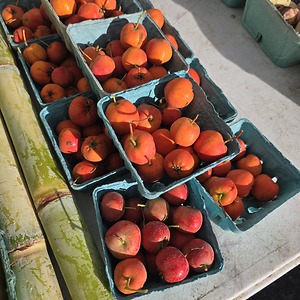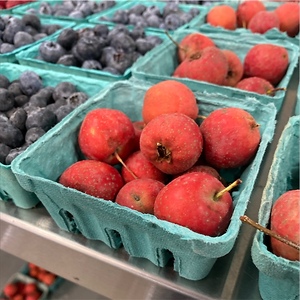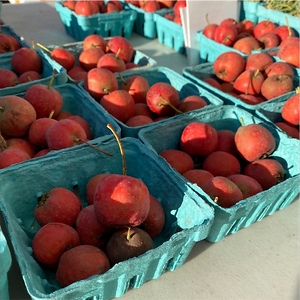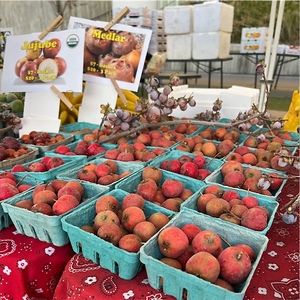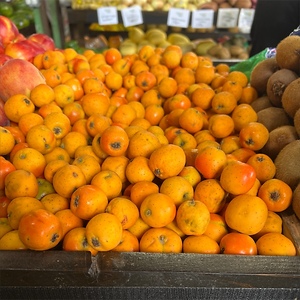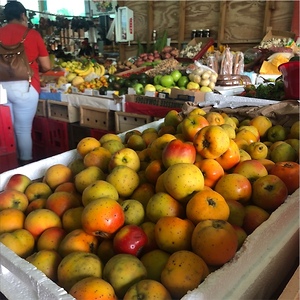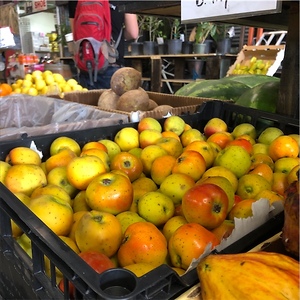

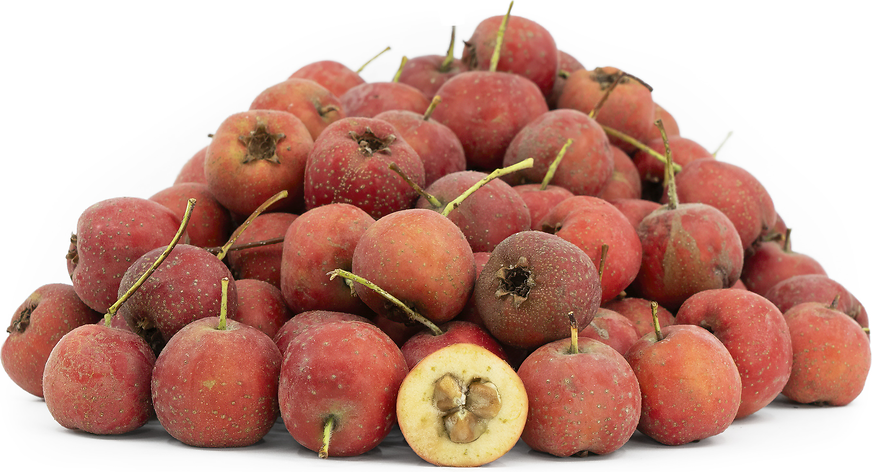
Hawthorn Apples
Estimated Inventory, bskt : 0
Description/Taste
Hawthorn apples are small fruits, ranging from 1 to 2 centimeters in diameter, and vary in size and overall appearance, depending on the specific variety. The fruits are generally round, conical, to ovate in shape, and often resemble miniature apples or berries, connecting to the tree through elongated, slender, and pliable green-brown stems. The fruit’s skin showcases variegated red, yellow, orange, dark purple, and black hues, based on the species, and generally has thin, taut, and semi-unnoticeable skin. The skin may also exhibit prominent lenticels, scarring, russet, dots, and streaking. Underneath the surface, the fruits bear a fleshy, dry, dense, mealy, crisp, and somewhat astringent pulp, depending on the variety. The pulp is typically cream-colored to ivory, tinged with green, and encases anywhere from 1 to 5 seeds. The seeds are clustered in the center and should be discarded as they are poisonous if ingested. Hawthorn apples can be eaten raw or cooked, but the fruits are customarily acidic, tart, sour, and astringent when raw. Some varieties may be sweeter than others. The fruits are popularly cooked with sweeteners to create a fruity-sweet taste with flavor nuances reminiscent of apples and berries.
Seasons/Availability
Hawthorn apples are harvested in the early fall through winter.
Current Facts
Hawthorn apples, botanically a part of the Crataegus genus, are a broad category of fruits belonging to the Rosaceae family. Over 380 species of Hawthorn apples have been found worldwide, and even though many species share the same genus, the fruits vary in shape, coloring, size, and flavor. One of the most commercially planted species is the Common Hawthorn or Crataegus monogyna, a species native to Northern Europe. Other Hawthorn varieties include Chinese Hawthorn, Mayhaw, Tejocote, Indian Hawthorn, Azarole, Oriental Hawthorn, Down Hawthorn, Fireberry Hawthorn, and Fleshy Hawthorn. Hawthorn apples are also referred to as haws or fruits. The haws grow in clusters along gnarled, twisted branches on shrubs or small deciduous trees reaching 5 to 15 meters in height, depending on the species, and are traditionally harvested in the fall as a culinary ingredient and beverage flavoring. Hawthorn apples hang well on the tree, allowing the fruits to be gathered over an extended period, and the fruit’s tangy, tart nature makes them a favored flavoring for jams, sauces, and preserves. Hawthorn trees are planted as a property barrier and ornamental in home gardens and public landscapes. Despite their similarities to crab apples, being self-fertile and sharing the same botanical family, it is important to note that Hawthorns are distinct from crab apples. Hawthorn species belong to the Crataegus genus, while crab apples belong to the Malus genus. Hawthorn trees also typically bear sharp spines extending up to ten centimeters in length, and crab apples are thornless.
Nutritional Value
Hawthorn apples are a source of fiber to regulate the digestive tract, vitamin C to boost the immune system, polyphenols to reduce inflammation and protect the cells against free radical damage, and calcium to build strong bones and teeth. The fruits also provide vitamin A to maintain healthy organ functioning, iron to develop the protein hemoglobin for oxygen transport through the bloodstream, magnesium to control nerve functioning, and other nutrients, including B vitamins, zinc, copper, phosphorus, and potassium. Each species of Hawthorn will vary in nutritional content. Throughout Asia and Europe, Hawthorn apples have been used in natural medicines for digestive ailments and heart problems. In Traditional Chinese Medicine, the fruits have been used since at least 659 CE to help reduce high blood pressure. Beyond vitamins and minerals, Hawthorn apple seeds contain cyanide and should not be ingested.
Applications
Hawthorn apples have a tart, tangy, and subtly sweet taste suited for cooked preparations. The fruits can be consumed raw and are sometimes eaten as a snack, but the seeds should be spat out and discarded. Hawthorn fruits can also be cored, skewered, and dipped in melted sugar, creating a crunchy-sweet snack often sold as a street food. When heated, Hawthorn apples are often paired with sugar to create a more balanced taste and are simmered into jams, jellies, and syrups. The fruits can also be cooked into dips, ketchup, and chutneys. Try incorporating Hawthorn apples into pie fillings or other fillings for other baked foods and pastries. The fruits can also be used to flavor candies. In addition to culinary preparations, Hawthorn apples are commonly infused into tea, wine, and other alcoholic beverages. The young leaves and flowers are also edible when in season and can be eaten raw or tossed into salads. Hawthorn apples pair well with other fruits such as plums, tangerines, and guavas, nuts including pecans, walnuts, and almonds, and spices such as anise, cinnamon, cloves, ginger, and nutmeg. Whole, unwashed Hawthorn apples should be immediately used for the best quality and flavor. The fruits will last up to one week when stored in a plastic bag in the refrigerator.
Ethnic/Cultural Info
Hawthorn trees frequently appear in folklore across Europe. During the Medieval Ages, Hawthorn trees were said to smell like death and the Plague. It was considered a bad omen to bring Hawthorn branches and plants into the house in Britain as many people believed it welcomed death into the home. Surprisingly, this unusual superstition was later explained using science. Some species of Hawthorn trees contain the chemical trimethylamine, a chemical produced when living things begin to decompose. This explains the correlation between the scent of Hawthorn and the smell of the Plague, as bodies were often decomposing before they were removed from villages and urban communities. In Croatia and Serbia, Hawthorn wood was once used to carve stakes to kill vampires. The tree’s wood is known for its hardness and was regarded as strong enough to slay the mythical creatures. In Northwestern Europe, bad luck will fall upon an individual who cuts down a Hawthorn tree, as the species is connected to fairies.
Geography/History
Hawthorn species are native to temperate regions of North America, Asia, and Europe and have been growing wild since ancient times. Each species has a specific history, native area, and natural expansion, and several parts of the plants have been valued over time for their medicinal, cultural, and culinary properties. Hawthorn species spread naturally in the wild, and human breeding also contributed to the plant’s presence worldwide. Hawthorn trees and shrubs were often used as property borders and protection hedges in the English countryside, and the plant became an ornamental species selected for public parks, gardens, and urban landscapes in the United States. Today, Hawthorn species are still growing wild and planted as a landscape plant in temperate regions worldwide. The trees or shrubs thrive in woodlands, pastures, hedgerows, scrublands, parks, and meadows, and are adaptable to a wide range of soils and sunny environments. When in season, Hawthorn apples are a specialty fruit primarily sold through growers or farmer’s markets.
Recipe Ideas
Recipes that include Hawthorn Apples. One
| Wild Walks |
|
Hawthorn Berry Fruit Leather |
| Omnivores Cookbook |
|
Hawthorn Berry Juice |
| China Sichuan Food |
|
Hawthorn Jam Recipe |



